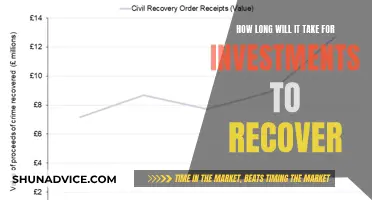
Investing is a great way to build wealth over time and achieve financial goals. Here are some key investments to consider:
- High-yield savings accounts: These offer higher interest rates than traditional savings accounts, helping your money grow faster.
- Long-term certificates of deposit (CDs): CDs are considered safe investments and can provide higher interest rates than savings accounts, especially during falling interest rates.
- Long-term corporate bond funds: These funds invest in bonds issued by corporations, offering higher yields than government bonds and a good option for income-focused investors.
- Dividend stock funds: Dividend stocks distribute a portion of their profits to shareholders, providing a regular income stream.
- Value stock funds: These funds invest in stocks that are bargain-priced relative to the market, offering the potential for capital appreciation.
- Small-cap stock funds: Investing in smaller companies with strong growth prospects can lead to significant gains but comes with higher risk.
- Real estate investment trusts (REITs): REITs offer diversified exposure to real estate and provide steady income through dividends.
- S&P 500 index funds: These funds track the performance of the S&P 500 index, providing diversified exposure to some of the largest and most successful US companies.
- Nasdaq-100 index funds: By investing in the Nasdaq-100 index, you gain exposure to leading tech companies and benefit from the potential for higher returns.
- Rental housing: Investing in rental properties can generate regular cash flow but requires active management and comes with associated risks.
| Characteristics | Values |
|---|---|
| Risk tolerance | High, Moderate, Low |
| Investment goals | Long-term, Short-term |
| Investment types | Stocks, Bonds, Mutual funds, ETFs, CDs, REITs, Index funds, Dividend stocks, Growth stocks, Defensive stocks, etc. |
| Investment accounts | Brokerage accounts, Retirement accounts, Managed accounts, Education savings accounts, Health savings accounts |
| Investment horizon | Long-term, Short-term |
| Investment research | Read financial news, Use stock simulators, Learn about diversification |
What You'll Learn

Long-term investments
- Robo-advisor portfolio: A robo-advisor will build a broadly diversified investment portfolio for you based on your goals, time horizon, and risk tolerance.
- Growth stocks: These are often tech companies that plough their profits back into the business, rarely paying out a dividend. They can be risky but have the potential for limitless rewards.
- Stock funds: A stock fund contains a collection of stocks, often unified by a specific theme or categorisation. They are less risky than buying individual stocks and can be purchased at any online broker.
- Bond funds: A bond fund contains many bonds from a variety of issuers. They are good for investors who want a diversified portfolio of bonds without having to analyse and buy individual bonds.
- Dividend stocks: Dividend stocks pay out a regular cash payout, making them attractive for older investors. They can be purchased at any online broker that offers stock trading.
- Value stocks: These are stocks that are cheaper on certain valuation metrics, such as a price-earnings ratio. They tend to do well when interest rates are rising.
- Target-date funds: These funds become more conservative as you age, making them safer as you approach retirement.
- Real estate: Investing in real estate can be attractive as it can be a source of passive income. However, it requires a significant amount of money to get started and there are high commissions involved.
- Small-cap stocks: These are stocks of relatively small companies that have the potential to grow quickly. They can be quite volatile but offer significant returns.
- Roth IRA: A Roth IRA is a retirement account that allows you to save with after-tax money and grow your money tax-free.
- High-yield savings accounts: These accounts pay interest on your cash balance and are a good option for those who need access to cash in the near future.
- Long-term certificates of deposit (CDs): CDs are issued by banks and offer a higher interest rate than savings accounts. They are considered safe investments but carry reinvestment risk.
- Long-term corporate bond funds: These funds are made up of bonds issued by corporations and are a good choice for investors looking for cash flow or those who want to reduce their portfolio risk while still earning a return.
- Dividend stock funds: Dividend stocks pay out a portion of a company's profit to shareholders, usually quarterly. Dividend stock funds reduce risk by diversifying across multiple companies.
- S&P 500 index funds: These funds are based on the largest American companies, providing broad, diversified exposure to the stock market. They are a good choice for beginning investors.
- Rental housing: Investing in rental housing can be a great way to generate regular cash flow, but it requires the willingness to manage properties and deal with tenants.
Goldman Sachs: Applications Flood In
You may want to see also

Short-term investments
High-yield savings accounts
High-yield savings accounts are a safe and easily accessible option, similar to a traditional savings account, but with a much higher return. They are insured by the Federal Deposit Insurance Corporation (FDIC) in the US, which means your money will be protected up to $250,000 per depositor per bank. They are also highly liquid, allowing you to withdraw money at any time. However, there may be a limit to the number of withdrawals or transfers you can make.
Money market accounts
Money market accounts are another type of bank deposit that usually pays a higher interest rate than regular savings accounts. They are also insured by the FDIC, up to $250,000 per depositor per bank. They offer variable interest rates and checking account features such as check-writing privileges, debit cards, and ATM access.
Short-term corporate bond funds
Corporate bonds are issued by major corporations to fund their investments. They are typically considered safe and pay interest at regular intervals. A short-term corporate bond fund is highly liquid and can be bought and sold on any day that the financial markets are open.
Short-term US government bond funds
Government bonds are issued by the federal government and its agencies. They are considered very safe and low-risk as they are backed by the full faith and credit of the US government. They are also highly liquid and can be bought and sold on any day the market is open.
Cash management accounts
Cash management accounts allow you to put money into a variety of short-term investments. They are highly liquid, allowing you to access your money quickly, and they may pay interest on your holdings. They are often invested in safe, low-yield money market funds.
No-penalty certificates of deposit (CDs)
CDs are time deposits where you agree to hold your money in an account for a specified period, ranging from a few weeks to several years. In exchange, the bank will pay you a higher interest rate. A no-penalty CD allows you to withdraw your money at any time without a fee, which is useful in a period of rising interest rates.
Treasury bills
Treasury bills, or T-bills, are a type of fixed-income security issued by the government with a short maturity term of within a year. They are nearly risk-free and highly liquid, making them a safe option for parking your cash. However, returns on T-bills typically react inversely to the Federal Reserve benchmark rate; a higher rate set by the Fed means lower returns on T-bills.
Short-term municipal bond funds
Municipal bonds, held in an ETF or mutual fund, can be attractive short-term investments due to their tax advantages, safety, and steady income. They offer tax-free interest and lower risk compared to stocks. However, yields are usually lower than corporate bonds, and returns may not keep up with inflation.
Peer-to-peer lending
If you're looking for an alternative to traditional banks and brokerages, you can explore online peer-to-peer lending platforms. These connect individuals or businesses seeking loans with investors. Pros include potentially higher returns compared to traditional savings accounts and the opportunity for diversification. However, there is a risk of borrower default and delinquencies, and loans are not FDIC-insured.
Investments: Relationships Need More Than Words
You may want to see also

Risk tolerance
An individual's risk tolerance is influenced by several factors, including age, investment goals, income, and future earning capacity. For example, a young person with a steady income and few financial obligations may have a higher risk tolerance than a retiree or someone approaching retirement age.
There are typically three types of risk tolerance: aggressive, moderate, and conservative. Aggressive investors have a higher risk tolerance and are willing to risk losing money for the potential of better returns. They often invest in stocks, equity funds, and exchange-traded funds (ETFs). On the other hand, conservative investors have a lower risk tolerance and seek investments with guaranteed returns, such as bank certificates of deposit (CDs), money markets, or U.S. Treasuries. Moderate investors fall between these two categories, adopting a "balanced" strategy that includes a mix of stocks and bonds.
It's important to note that risk tolerance is not static and can change over time as an individual's financial circumstances, goals, and risk appetite evolve. Additionally, risk tolerance is closely linked to the time horizon of an investment. For long-term financial goals, investors may be willing to take on more risk to achieve potentially higher returns. In contrast, short-term financial goals may be better suited to lower-risk cash investments.
When determining your risk tolerance, it's essential to assess your financial situation, goals, and comfort level with risk honestly. Online risk tolerance assessments and questionnaires can also provide valuable insights. By understanding your risk tolerance, you can make informed decisions about your investment portfolio and choose investments that align with your tolerance for risk and potential losses.
Maximizing Returns: Navigating the Investment Landscape
You may want to see also

Diversification
The primary goal of diversification is to limit the impact of volatility on a portfolio. By investing in a range of assets, you reduce the likelihood that market shocks will affect all your investments. Diversification can also help to smooth out unsystematic risk events, where the positive performance of some investments offsets the negative performance of others.
There are several ways to diversify a portfolio:
- Asset classes: Diversification can be achieved by investing in different asset classes such as stocks, bonds, real estate, and cryptocurrencies. Stocks are considered the most aggressive portion of a portfolio, offering higher growth potential over the long term but carrying greater risk. Bonds, on the other hand, provide regular interest income and are generally less volatile than stocks. Short-term investments like money market funds and certificates of deposit (CDs) are also considered more stable and conservative options.
- Geographic locations: Investing in securities from different countries can provide protection against risks specific to a particular country or region. For example, investing in Japanese equities and Australian bonds can offer a cushion against losses during an economic downturn in the US.
- Industries: Diversifying across industries can reduce the impact of sector-specific risks. For instance, investing in both travel and digital streaming entertainment can hedge against the risk of future pandemic-related shutdowns.
- Company size: Investing in a mix of large-cap and small-cap companies can provide a balance between stability and growth potential. Large-cap stocks like Apple tend to be safer, while small-cap stocks have more room to grow.
- Market capitalizations: Diversification can also be achieved by investing in securities with different market capitalizations. For example, Apple and Newell Brands Inc. are both in the S&P 500 but have vastly different operational approaches and market caps.
- Risk profiles: Within each asset class, investors can choose the underlying risk profile of the security. For instance, with fixed-income securities, investors can opt for low-risk government bonds or high-risk bonds issued by private companies.
- Term lengths: Diversification can be achieved by investing in income-generating investments with different term lengths. Longer-term investments tend to offer higher returns but carry more risk due to fluctuations in interest rates.
- Platforms: Diversifying across platforms or exchanges can help spread the risk of loss. For example, during the Celsius Network bankruptcy in 2022, investors who held cryptocurrency across multiple exchanges reduced their risk of loss.
It's important to note that while diversification can help manage risk, it may also reduce potential gains. Diversification limits your upside, especially in the short term, by spreading out your investments. Additionally, a highly diversified portfolio can be more time-consuming to manage and may incur higher transaction fees and commissions.
The NFT Investment Craze: Why?
You may want to see also

Financial goals
Set Clear and Precise Goals
Clearly define your financial objectives, specifying both short-term and long-term goals. For example, instead of a vague goal like "saving for retirement," aim for a specific target like "accumulating $500,000 in my retirement fund by age 50." This precision will help guide your investment decisions and ensure your actions are aligned with your intentions.
Evaluate Your Risk Tolerance
Understanding your risk tolerance is crucial. Reflect on your comfort level with the inherent uncertainties of the stock market. Are you willing to take on higher risks for potentially greater returns, or do you prefer stability even if it means potentially lower returns? Your risk tolerance will influence the types of investments you make, so be honest with yourself to ensure your investments align with your personal comfort level.
Long-Term Focus
Investing is typically a long-term endeavour. While short-term market timing may be tempting, it often leads to losses. Focus on your long-term goals and stick to a disciplined, buy-and-hold strategy. Remember, time is on the side of the investor, and riding out the ups and downs of the market can lead to better results over time.
Diversification
Diversification is a key strategy to mitigate risk and improve your potential for returns. Spread your investments across different asset classes, such as stocks, bonds, real estate, and more. By not putting all your eggs in one basket, you reduce your dependence on the performance of any single investment. Additionally, different asset types react differently to market changes, so a diversified portfolio can provide a buffer during volatile times.
Regular Review and Rebalancing
Investments within your portfolio will grow at different paces, and your circumstances may change over time. Therefore, it's essential to regularly review and rebalance your portfolio to ensure it remains aligned with your financial goals. An annual review with a financial advisor can help you fine-tune your investments and make any necessary adjustments.
Education and Learning
Successful investors are lifelong learners. Stay informed about the global economy, industry trends, and the companies you invest in. Read reputable financial news sites, books on investment strategies, and use resources like stock simulators to practice trading risk-free. The more you know, the better equipped you'll be to make informed investment decisions.
Quantum Computers: The Next Investment Boom
You may want to see also







